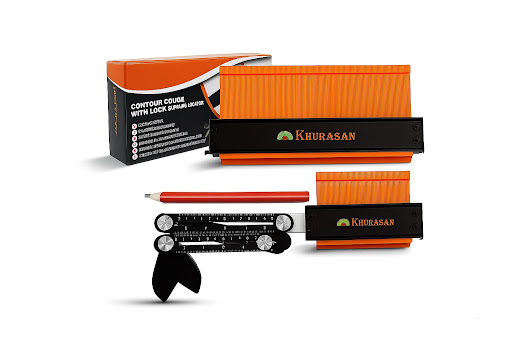Wood Contour Gauge – The Secret Tool for DIY & Woodworking

If you’ve ever worked on a home project or tried your hand at woodworking, you’ll know one thing for certain: shapes and edges are never as simple as they look. Anyone can make a straight cut with a saw, but things get complicated the moment you need to fit wood around pipes, curves, or uneven walls. What should be a quick job suddenly becomes an endless cycle of trial and error—cutting, checking, trimming, and sometimes even wasting expensive materials.
This is a frustration that not only beginners face but also experienced professionals. Even the sharpest saw won’t solve the problem if you don’t have the exact contour of the object you’re working around. That’s where the Wood Contour Gauge comes in. A small, inexpensive tool that looks simple but saves hours of effort and gives your work the kind of finish that looks professionally done.
Why Shapes Are the Toughest Part of Woodworking
Woodworking isn’t only about joining two pieces of wood—it’s about precision, alignment, and achieving a flawless fit. One wrong cut can spoil the beauty of an entire project. Think of installing a new wooden floor around a round radiator pipe. A few millimeters of error leaves you with an ugly gap that will never go unnoticed.
Straight rulers and tape measures work fine for simple edges, but curves are unforgiving. Unlike lines, they can’t be estimated or guessed at. That’s why professionals, and increasingly DIY enthusiasts, trust tools like contour gauges. They don’t just help—they eliminate guesswork entirely, giving you the exact shape instantly.
How Does a Wood Contour Gauge Actually Work?
The working mechanism of a contour gauge is brilliantly straightforward. The tool is made up of dozens of thin pins tightly packed inside a frame. When you press it against any object, the pins move to take on its exact shape. The outline stays intact, giving you a ready-to-use copy of that contour.
Once you capture the outline, you can place the gauge directly on wood, laminate, vinyl, tiles, or even metal sheets and trace the exact curve. No complicated calculations. No trial-and-error cuts. The copied contour mirrors the surface perfectly, allowing you to achieve a seamless fit.
That’s why it’s often called a profile gauge—because it captures the true profile of whatever you press it against.
Real-Life Problems Made Simple
Most people assume contour gauges are only useful for professional carpenters. In reality, this tool is incredibly handy for small home projects as well. Just think of the following:
- Cutting tiles neatly around bathroom pipes.
- Installing laminate flooring against uneven walls.
- Creating shelves that sit flush against a brick wall.
- Fitting skirting boards perfectly in corners.
Without a contour gauge, these projects would take hours and likely result in wasted material. With it, you simply press, trace, and cut. Even a beginner can achieve the same clean finish that a professional would deliver.
Why You Need One in Your Toolbox
Tools are supposed to make life easier. Yet, many are complex, heavy, or require learning curves. The beauty of the contour gauge is in its simplicity. It’s affordable, durable, and delivers results instantly.
Here are a few reasons why every DIYer should own one:
- Time saver – Get precise outlines in seconds.
- Money saver – No wasted tiles, laminate, or wood from wrong cuts.
- Accuracy booster – Curves and corners match perfectly the first time.
- Multi-purpose – Works on wood, tile, carpet, vinyl, metal, or plastic.
- Beginner friendly – Anyone can use it without training.
For a tool that pays for itself after just one use, the contour gauge is a must-have.
Different Versions of Contour Gauges Explained
When you start shopping for contour gauges, you’ll notice they come in different variations. While they all serve the same purpose, each type is designed with slightly different projects in mind. Below, we’ll explore the three most common listings—rewritten as individual detailed explanations instead of short points.
The Complete Set: 10” & 5” Contour Gauges with Locking, Adjustable Screws, 3-Fold Angle Ruler, and Hard Pencil
For those who want an all-in-one solution, the complete set is the most versatile choice. This package usually includes a large 10-inch contour gauge, a compact 5-inch version, both equipped with locking and adjustable screws, along with a 3-fold angle ruler and a sturdy pencil. Together, these tools provide the flexibility to tackle just about any job, whether small or large.
The 10-inch gauge is perfect for bigger projects such as flooring, furniture making, or fitting panels against walls. It captures wide contours easily in a single press. The 5-inch gauge, on the other hand, is ideal for those tight corners, narrow gaps, and smaller details that larger gauges might struggle with. Having both sizes means you’ll always have the right tool for the job.
The locking mechanism ensures that once you capture a shape, it won’t shift while transferring. The 3-fold angle ruler adds even more accuracy when working with tricky angled cuts. And the pencil ensures that every trace you make is clean and visible. For both professionals and hobbyists, this set feels like a complete mini toolkit that prepares you for any project.

The 10-Inch Contour Gauge with Locking, Adjustable Screws, and Carpentry Pencil
If most of your work involves medium to large projects, the standalone 10-inch contour gauge is a strong choice. Its longer design allows you to capture wide contours, making it particularly useful for flooring installations, large furniture pieces, or wall trims.
What sets this tool apart is its locking pins. Without locking, the pins can shift while moving the gauge, and you lose accuracy. With the locking system, the shape stays frozen until you’re ready to transfer it. The adjustable screws allow you to fine-tune the tension, which means smoother operation and more reliable outlines.
The included carpentry pencil adds another layer of convenience. Whether you’re working on wood, tiles, or laminate, the pencil lets you mark contours clearly and trace without hassle. For anyone who frequently works with wide surfaces, this tool alone can make a noticeable difference in both speed and accuracy.

The 5-Inch Contour Gauge with Locking, Adjustable Screws, and Carpentry Pencil
Compact, lightweight, and easy to carry, the 5-inch contour gauge is perfect for detail-oriented projects. Its smaller size makes it especially useful in places where larger gauges are awkward to use. Think of cutting wood around pipes, shaping small corners, or working on tight-fitting trims.
The locking mechanism ensures that once you press the gauge against a shape, the outline doesn’t shift while you’re transferring it. This makes it perfect for delicate work where precision is everything. The adjustable screws give you flexibility, letting you set the pins according to the surface.
It also comes with a carpentry pencil, ensuring you can immediately trace the outlines onto your material. For anyone who often works in confined spaces or enjoys doing detailed DIY projects, this smaller gauge is a must-have companion.
Features That Really Matter
When buying a contour gauge, not all features are equally important. Here’s what you should look for:
- Size: 5-inch for small details, 10-inch for bigger projects, or a set for maximum flexibility.
- Locking system: Keeps pins in place for accurate transfers.
- Pin thickness: The thinner the pins, the more precise the contour.
- Build material: ABS plastic is common, but metal versions are stronger (though heavier).
- Accessories: Pencils and angle rulers add extra convenience.
Practical Scenarios Where Contour Gauges Save the Day
Imagine you’re laying down laminate flooring, and you suddenly reach a radiator pipe. Without a contour gauge, you’d be stuck with guesswork or multiple failed cuts. With a 10-inch gauge, you press it against the pipe, lock the shape, trace, and cut. The board fits seamlessly on the first try.
Or consider a hallway with uneven walls where you’re installing skirting boards. A 5-inch gauge is perfect for this. It captures every bump and curve so that when you cut the wood, it sits snugly without gaps. These little wins make a big difference in the overall look of a project.
Why Even Professionals Use Them
For professionals, time is money. Carpenters, flooring experts, and tilers could technically measure and cut freehand, but why risk errors when a contour gauge guarantees precision? It’s not about replacing skill—it’s about increasing efficiency. That’s why even seasoned craftsmen rely on it daily.
Beyond Just Wood
Despite its name, the contour gauge isn’t limited to woodworking. Its uses extend across multiple areas:
- Tiling – Fitting tiles around bathroom or kitchen fixtures.
- Flooring – Shaping laminate or vinyl around corners.
- Auto repair – Matching car body panels.
- Crafts – Tracing shapes in leather, fabric, or art projects.
It’s truly a universal tool for anyone working with shapes.
When to Upgrade
If you start with a small 5-inch gauge, you’ll eventually realize it’s not enough for larger tasks. That’s when upgrading to a 10-inch or a full set makes sense. Locking versions are always worth the investment since they provide consistent accuracy.
Building Confidence for DIYers
Many people hesitate to take on DIY projects because they’re afraid of making mistakes. The contour gauge helps eliminate that fear by giving exact outlines and reducing the chances of error. With cleaner results and fewer wasted materials, beginners gain the confidence to take on bigger challenges.
Affordable, Reliable, and Long-Lasting
Unlike power tools that require maintenance, contour gauges are inexpensive and built to last. A high-quality gauge can serve you for years with minimal care. That’s why most homeowners and professionals keep both sizes in their toolbox.
Final Thoughts
The Wood Contour Gauge might not look glamorous, but it’s one of the most effective tools you can own. It saves time, prevents mistakes, and ensures your work looks sharp and professional. Whether you go for the complete set with all accessories, the standalone 10-inch for big projects, or the compact 5-inch for smaller details, you’ll quickly realize why this tool feels like a secret weapon.
The next time you face an awkward corner, a tricky curve, or an uneven surface, having this little gadget by your side will make the job faster, easier, and far more satisfying.





